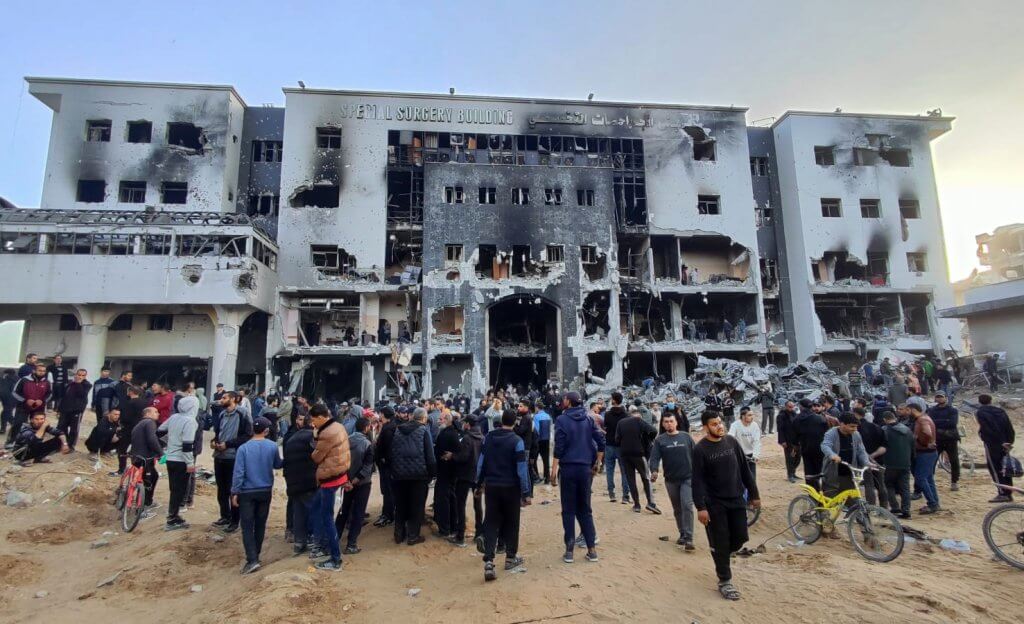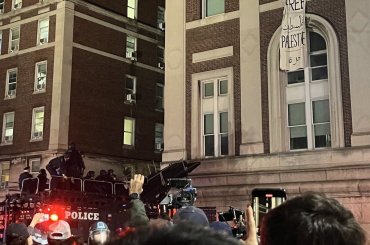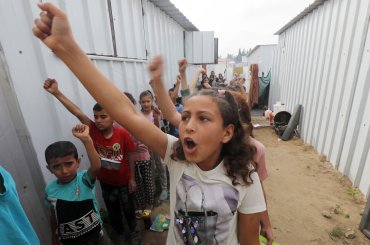The fall of al-Shifa Hospital will be remembered as one of the most pivotal moments in Israel’s genocidal campaign in Gaza — not for the unbridled annihilationism it displayed, but because it offered a unique window into the real reason Israel decided to systematically dismantle Gaza’s hospitals.
Hospitals in Gaza during times of war have not only served as places for the treatment of the wounded and the sick but have become pivotal social institutions, housing a microcosm of Gaza’s entire civic order. They became hubs for journalists and human rights defenders, offered space for Gaza’s Civil Defense teams to organize and coordinate rescue efforts, became a base of operations for Gaza’s police force, and hosted tens of thousands of displaced refugees seeking shelter from the bombardment. Hospitals became all those things because they were the last remaining civilian institutions that were supposed to enjoy a modicum of protection from the war.
In other words, they housed all the trappings of what makes a society function. In lieu of dismantling Gaza’s resistance infrastructure, a goal that remains elusive for the Israeli army, one of Israel’s war aims in Gaza has been to engineer social collapse.
Normalizing attacks on hospitals
It started with Israel’s first assault on al-Shifa on November 15. In the days leading up to the invasion, the hospital had been placed under siege, as medical staff and doctors were shot through windows and in the hospital’s main courtyard. When others rushed out to try and save them, they were shot down, too, until no one dared leave the buildings. The injured were left to bleed out and die, and then to rot and be eaten by stray animals. When the Israeli army entered, it cleared out the hospital of its staff, patients, and displaced refugees. Israeli propaganda began to flood the media with images of weapons stuffed behind an MRI machine, one of the few flimsy pieces of “evidence” alleging the hospital’s use as a military “command-and-control center.”
But despite the fact that Israel’s claims about al-Shifa turned out to be baseless, the invasion set an important precedent for what was considered acceptable conduct throughout the war. What was previously unthinkable now became commonplace, setting the stage for what was to come.
Facilitating social collapse
After the army withdrew from parts of northern Gaza toward the end of the year, including the area surrounding al-Shifa, medical staff and patients returned to the hospital. Al-Shifa quickly resumed its status as a hub for displaced persons and civil society actors. But with the start of the new year, famine and starvation began to set in. The systematic deprivation of food aid and the targeting of aid-seekers at the Kuwaiti and Nabulsi roundabouts in northern Gaza led to several massacres that created a crisis for the local population.
Then, in what was universally hailed as a remarkable achievement, a convoy of 13 aid trucks finally arrived in the north without incident on March 17. The difference is that this time, the delivery of aid had been directly coordinated by Gaza’s police force. The key figure who organized the delivery was the Director of police operations, Faiq Mabhouh, and like most of Gaza’s civilian employees, he naturally operated out of al-Shifa. The next day, on March 18, Israel launched its second invasion of the hospital.
Unsurprisingly, Israel recycled the same unsubstantiated claims, asserting that the operation was based on “precise intelligence” that indicated the hospital was housing hundreds of military personnel from which “terrorist attacks” were being conducted. On the first day of the attack, Israeli forces assassinated Mabhouh, while killing dozens more within the medical compound. Early on, Mondoweiss demonstrated the real reason behind the attack, which was to strike a blow at Gaza’s civil infrastructure with the objective of causing chaos and undermining its ability to function.
Mabhouh had overseen several popular committees in coordination with local tribes to organize the delivery of aid to the starving population. It was becoming clear that the Hamas government was attempting to reestablish a foothold in northern Gaza and to restore order, signs of which could be gleaned as early as February. Of course, for Israel, any governmental employee in Gaza, even if in civilian branches like the police, were, for all intents and purposes, “Hamas operatives,” no different from resistance fighters in the Qassam Brigades. This also included the members of the popular and tribal committees responsible for delivering aid, which Israel continued to target in northern Gaza as the siege of al-Shifa commenced.
Nearly two weeks later, on March 31, the popular and tribal committees announced that they would halt the coordination and delivery of aid in northern Gaza after over 70 of its members had been killed by the Israeli army. The committees put out a statement saying that the army had systematically targeted the committees and that it was deliberately sowing “chaos and starvation” by preventing international organizations like the Red Cross, UNRWA, and the World Food Program from delivering aid. By the time the Israeli army withdrew from al-Shifa, the Gaza Media Office said that at least 400 Palestinians were killed and 900 were wounded during the two-week raid. Buildings that were not destroyed were set on fire and irreparably damaged. The army vowed that al-Shifa would not return to being operational.
Creating the ‘kill zone’
As the siege of al-Shifa continued over the course of two weeks, news began to emerge of atrocities and wholesale massacres in the hospital. After the invasion had concluded, countless testimonies detailed field executions, with Civil Defense teams reporting finding dead bodies buried in the sand with their legs bound.
A day before the army withdrew, Haaretz published a report providing new insight into how the army has operated throughout the war, creating “kill zones” where soldiers have been instructed to shoot anyone on sight. The report defines such zones as “an area in which a force sets itself up, usually in an abandoned house, with the area surrounding it becoming a closed military area, but with no clear marking as such.” Of course, these “kill zones” are also located in the middle of residential neighborhoods, many of which were unevacuated.
The report provides a useful framework for understanding how the invasion of al-Shifa likely unfolded.
It starts by referencing the infamous targeting of four unarmed men in Khan Younis by an Israeli drone early in January, asserting that the incident was one of many in which Palestinian civilians were killed while being declared as “terrorists” by the army without evidence.
The report gathers testimony from numerous Israeli soldiers, “senior” army officials, and multiple reserve and standing army commanders that all “cast doubt on the claim that all of these were terrorists,” implying that “the definition of terrorist is open to a wide range of interpretation. It’s quite possible that Palestinians who never held a gun in their lives were elevated to the rank of ‘terrorist’ posthumously, at least by the IDF.”
“It’s not that we invent bodies, but no one can determine with certainty who is a terrorist and who was hit after entering the combat zone,” a reserve officer told Haaretz. Another reserve officer said that “in practice, a terrorist is anyone the IDF has killed in the areas in which its forces operate.” The officer said that the Israeli army’s reports of the number of resistance fighters it had allegedly killed were “astonishing” and that “you don’t need to be a genius to realize that you don’t have hundreds or dozens of armed men running through the streets.”
Rather, soldier testimonies assert that many of these people were likely desperate noncombatants who stumbled into areas they thought the army had evacuated in search of food. “When they went to such places, they were shot, perceived as people who could harm our forces,” one commander told Haaretz.
Yet the army’s definition of perceived “threats” is equally capacious. “As soon as people enter [a kill zone], mainly adult males, orders are to shoot and kill, even if that person is unarmed,” a reserve officer told Haaretz. Another soldier who had been in northern Gaza said that “the feeling we had was that there weren’t really rules of engagement there,” while a senior defense establishment official told Haaretz that it seems that “many combat forces are writing their own rules of engagement.”
These soldier testimonies are consistent with eyewitness and human rights reports in northern Gaza, which also detail the targeting of children with live bullets and the use of Palestinians as human shields during the raid of al-Shifa. While none of this brings a particularly new revelation to understanding Israel’s atrocities, the soldier testimonies are valuable in revealing the use of “kill zones” as an operational framework for conducting field activity.
This brings us back to the assault on al-Shifa. According to Ynet, the Israeli army said it conducted a “precise” operation that “distinguished between terrorists and civilians,” but that the priority of the security of Israeli soldiers always remained paramount. That’s why, according to the army, “faced with the risk of security of our forces, we open fire to eliminate terrorists when a threat was detected.”
In other words, all of al-Shifa Hospital and its surrounding area was turned into a giant kill zone.



Thanks for saying what the MSM won’t.
Israel’s Savage Destruction Of Gaza’s Healthcare System Is Exactly What It Looks Like
Caitlin Johnstone
Apr 01, 2024
“Israel has ended its assault on the al-Shifa Hospital in Gaza, because there is nothing left to assault.
The facility — the largest medical complex in Gaza where hundreds of civilians had been sheltering — is now an empty, unusable, burnt-out husk. Witnesses report hundreds of corpses in and around the complex, with video footage showing human body parts protruding from the earth and bodies with zip ties on their wrists.
Israel is currently doing its usual song and dance where it claims the hospital was a Hamas headquarters and everyone it killed there was a “terrorist”, but at this point the only people buying that schtick are the ones who desperately need to. This was a massacre of profound savagery. It’s as plain as day to anyone who isn’t deeply invested in pretending otherwise.
Israel, which at the beginning of the Gaza onslaught had adamantly denied that it would ever attack a hospital, has since launched hundreds of documented attacks on Gaza’s healthcare services and has destroyed most of its healthcare system. Just today the director-general of the World Health Organization announced that an Israeli airstrike on Gaza’s al-Aqsa Hospital compound killed four people and injured seventeen.”
https://www.caitlinjohnst.one/p/israels-savage-destruction-of-gazas
“breakdown in social order” Destroy hospital, block humanitarian aid, kill humanitarian workers. Israel is so vicious…they try to destroy UNRWA then went after World Central Kitchen. They are willing to do anything to stop food aid etc from getting to the Palestinians.
In my opinion it’s getting harder and harder to deny that the goal of Israel is to cause social collapse in Gaza. Recently the New York Review of Books Online posted this article ( unfortunately you probably won’t get access unless you subscribe ):
The Road To Famine in Gaza..Israel has not been content with preventing food from entering the Strip. Since the war began it has also destroyed more than one third of Gaza’s agricultural land, more than one fifth of its greenhouses, and one third of its irrigation infrastructure—all vital sources of food. Forensic Architecture claims that “the destruction of agricultural land and infrastructure in Gaza is a deliberate act of ecocide.”….In other words, well before the current war, Israel had rendered the majority of Gaza’s inhabitants destitute and undernourished. Newborn children were seven times likelier to die than if they had been born an hour’s drive away in Beersheba or Tel Aviv….With each new development, one can only wonder what more Israel intends to do to annihilate Gaza’s population and render the region’s recovery impossible.
https://www.nybooks.com/online/2024/03/30/the-road-to-famine-in-gaza/
Israel’s continuing attacks against Hamas are causing massive collateral damage to agricultural livelihoods and food supplies in the Gaza Strip. More than one third of agricultural lands in Gaza have been damaged since the outbreak of the war on October 7, 2023, according to analysis based on satellite imagery by the United Nations Satellite Centre (UNOSAT) and the UN Food and Agriculture Organization (FAO).
https://www.ifpri.org/blog/long-lasting-devastation-livelihoods-damage-agricultural-lands-gaza#:~:text=More%20than%20one%20third%20of,and%20Agriculture%20Organization%20(FAO).
MIDDLE EAST IN DEPTH WITH LAITH MAROUF EPISODE 8 – ISRAEL ATTACKS IRANIAN CONSULATE – RUSSIA FURIOUS and they discuss the sacking of Al Shifa
https://youtu.be/9JoP0nR4xiY?si=XR20BmZ-BhmKnQrb